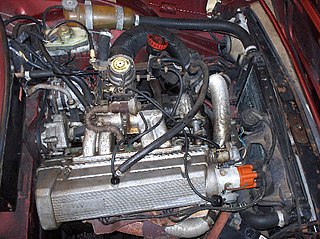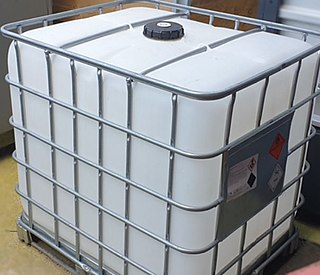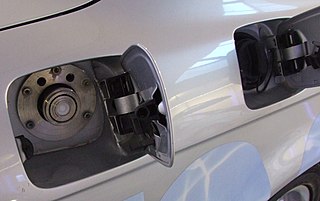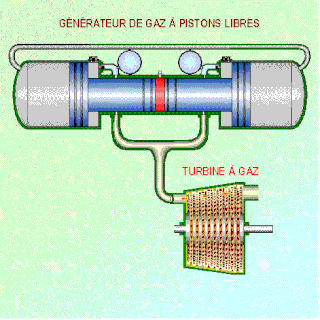Related Research Articles

In internal combustion engines, exhaust gas recirculation (EGR) is a nitrogen oxide (NOx) emissions reduction technique used in petrol/gasoline, diesel engines and some hydrogen engines. EGR works by recirculating a portion of an engine's exhaust gas back to the engine cylinders. The exhaust gas displaces atmospheric air and reduces O2 in the combustion chamber. Reducing the amount of oxygen reduces the amount of fuel that can burn in the cylinder thereby reducing peak in-cylinder temperatures. The actual amount of recirculated exhaust gas varies with the engine operating parameters.

A four-strokeengine is an internal combustion (IC) engine in which the piston completes four separate strokes while turning the crankshaft. A stroke refers to the full travel of the piston along the cylinder, in either direction. The four separate strokes are termed:
- Intake: Also known as induction or suction. This stroke of the piston begins at top dead center (T.D.C.) and ends at bottom dead center (B.D.C.). In this stroke the intake valve must be in the open position while the piston pulls an air-fuel mixture into the cylinder by producing a partial vacuum in the cylinder through its downward motion.
- Compression: This stroke begins at B.D.C, or just at the end of the suction stroke, and ends at T.D.C. In this stroke the piston compresses the air-fuel mixture in preparation for ignition during the power stroke (below). Both the intake and exhaust valves are closed during this stage.
- Combustion: Also known as power or ignition. This is the start of the second revolution of the four stroke cycle. At this point the crankshaft has completed a full 360 degree revolution. While the piston is at T.D.C. the compressed air-fuel mixture is ignited by a spark plug or by heat generated by high compression, forcefully returning the piston to B.D.C. This stroke produces mechanical work from the engine to turn the crankshaft.
- Exhaust: Also known as outlet. During the exhaust stroke, the piston, once again, returns from B.D.C. to T.D.C. while the exhaust valve is open. This action expels the spent air-fuel mixture through the exhaust port.

Fuel efficiency is a form of thermal efficiency, meaning the ratio of effort to result of a process that converts chemical potential energy contained in a carrier (fuel) into kinetic energy or work. Overall fuel efficiency may vary per device, which in turn may vary per application, and this spectrum of variance is often illustrated as a continuous energy profile. Non-transportation applications, such as industry, benefit from increased fuel efficiency, especially fossil fuel power plants or industries dealing with combustion, such as ammonia production during the Haber process.

Alternative fuels, also known as non-conventional and advanced fuels, are fuels derived from sources other than petroleum. Alternative fuels include gaseous fossil fuels like propane, natural gas, methane, and ammonia; biofuels like biodiesel, bioalcohol, and refuse-derived fuel; and other renewable fuels like hydrogen and electricity.
Lean-burn refers to the burning of fuel with an excess of air in an internal combustion engine. In lean-burn engines the air–fuel ratio may be as lean as 65:1. The air / fuel ratio needed to stoichiometrically combust gasoline, by contrast, is 14.64:1. The excess of air in a lean-burn engine emits far less hydrocarbons. High air–fuel ratios can also be used to reduce losses caused by other engine power management systems such as throttling losses.

The methanol economy is a suggested future economy in which methanol and dimethyl ether replace fossil fuels as a means of energy storage, ground transportation fuel, and raw material for synthetic hydrocarbons and their products. It offers an alternative to the proposed hydrogen economy or ethanol economy, although these concepts are not exclusive. Methanol can be produced from a variety of sources including fossil fuels as well as agricultural products and municipal waste, wood and varied biomass. It can also be made from chemical recycling of carbon dioxide.
Homogeneous charge compression ignition (HCCI) is a form of internal combustion in which well-mixed fuel and oxidizer are compressed to the point of auto-ignition. As in other forms of combustion, this exothermic reaction produces heat that can be transformed into work in a heat engine.
In internal combustion engines, water injection, also known as anti-detonant injection (ADI), can spray water into the incoming air or fuel-air mixture, or directly into the combustion chamber to cool certain parts of the induction system where "hot points" could produce premature ignition. In jet engines — particularly early turbojets or engines in which it is not practical or desirable to have an afterburner — water injection may be used to increase engine thrust, particularly at low-altitudes and at takeoff.
Gasoline gallon equivalent (GGE) or gasoline-equivalent gallon (GEG) is the amount of an alternative fuel it takes to equal the energy content of one liquid gallon of gasoline. GGE allows consumers to compare the energy content of competing fuels against a commonly known fuel, namely gasoline.

Oxyhydrogen is a mixture of hydrogen (H2) and oxygen (O2) gases. This gaseous mixture is used for torches to process refractory materials and was the first gaseous mixture used for welding. Theoretically, a ratio of 2:1 hydrogen:oxygen is enough to achieve maximum efficiency; in practice a ratio 4:1 or 5:1 is needed to avoid an oxidizing flame.

Various alcohols are used as fuel for internal combustion engines. The first four aliphatic alcohols are of interest as fuels because they can be synthesized chemically or biologically, and they have characteristics which allow them to be used in internal combustion engines. The general chemical formula for alcohol fuel is CnH2n+1OH.
Fuel-saving devices are sold on the aftermarket with claims they may improve the fuel economy, the exhaust emissions, or optimize ignition, air flow, or fuel flow of automobiles in some way. An early example of such a device sold with difficult-to-justify claims is the 200 mpg‑US (1.2 L/100 km) carburetor designed by Canadian inventor Charles Nelson Pogue.

A bivalent engine is an engine that can use two different types of fuel. Examples are petroleum/CNG and petroleum/LPG engines, which are widely available in the European passenger vehicle aftermarket.
A water-fuelled car is an automobile that hypothetically derives its energy directly from water. Water-fuelled cars have been the subject of numerous international patents, newspaper and popular science magazine articles, local television news coverage, and websites. The claims for these devices have been found to be pseudoscience and some were found to be tied to investment frauds. These vehicles may be claimed to produce fuel from water on board with no other energy input, or may be a hybrid claiming to derive some of its energy from water in addition to a conventional source. According to the currently accepted laws of physics, there is no way to extract chemical energy from water alone.

An alternative fuel vehicle is a motor vehicle that runs on alternative fuel rather than traditional petroleum-based fossil fuels such as gasoline, petrodiesel or liquefied petroleum gas (autogas). The term typically refers to internal combustion engine vehicles or fuel cell vehicles that utilize synthetic renewable fuels such as biofuels, hydrogen fuel or so-called "Electrofuel". The term can also be used to describe an electric vehicle, which should be more appropriately called an "alternative energy vehicle" or "new energy vehicle" as its propulsion actually rely on electricity rather than motor fuel.

A free-piston engine is a linear, 'crankless' internal combustion engine, in which the piston motion is not controlled by a crankshaft but determined by the interaction of forces from the combustion chamber gases, a rebound device and a load device.
The Glossary of fuel cell terms lists the definitions of many terms used within the fuel cell industry. The terms in this fuel cell glossary may be used by fuel cell industry associations, in education material and fuel cell codes and standards to name but a few.

A hydrogen internal combustion engine vehicle (HICEV) is a type of hydrogen vehicle using an internal combustion engine that burns hydrogen fuel. Hydrogen internal combustion engine vehicles are different from hydrogen fuel cell vehicles. Instead, the hydrogen internal combustion engine is simply a modified version of the traditional gasoline-powered internal combustion engine. The absence of carbon means that no CO2 is produced, which eliminates the main greenhouse gas emission of a conventional petroleum engine.

An internal combustion engine is a heat engine in which the combustion of a fuel occurs with an oxidizer in a combustion chamber that is an integral part of the working fluid flow circuit. In an internal combustion engine, the expansion of the high-temperature and high-pressure gases produced by combustion applies direct force to some component of the engine. The force is typically applied to pistons, turbine blades, a rotor, or a nozzle. This force moves the component over a distance. This process transforms chemical energy into kinetic energy which is used to propel, move or power whatever the engine is attached to.
References
- ↑ NASA Technical Note, May 1977, "Emissions and Total Energy Consumption of a Multicylinder Piston Engine Running on Gasoline and a Hydrogen–Gasoline Mixture" (Accessed 2022-04-06)
- ↑ Hydrogen Internal Combustion Engine Vehicles Archived 2012-12-12 at archive.today Idaho National Laboratory
- ↑ G. Fontana; E. Galloni; E. Jannelli; M. Minutillo (January 2002). "Performance and Fuel Consumption Estimation of a Hydrogen Enriched Gasoline Engine at Part-Load Operation". SAE Technical Paper Series (2002–01–2196): 4–5.
- ↑ Mathur H.B.; Das L.M. (1991). "Performance characteristics of a Hydrogen Fueled SI Engine using Timed Manifold Injection". International Journal of Hydrogen Energy. 16: 115–127. doi:10.1016/0360-3199(91)90038-K.
- ↑ Per Tunestal; Magnus Christensen; Patrik Einewall; Tobias Andersson; Bengt Johansson (January 2002). "Hydrogen Addition For Improved Lean Burn Capability of Slow and Fast Natural Gas Combustion Chambers". SAE Technical Paper Series (2002–01–2686): 7–8.
- ↑ Tsolakis A, Megaritis A, Wyszynski ML, "Application of exhaust gas fuel reforming in compression ignition engines fueled by diesel and biodiesel fuel mixtures" Energy & Fuels 17 (6): 1464–1473 NOV-DEC 2003.
- ↑ Yougen Kong; Sam Crane; Palak Patel; Bill Taylor (January 2004). "NOx Trap Regeneration with an On-Board Hydrogen Generation Device". SAE Technical Paper Series (2004–01–0582): 6–7.
- ↑ Thorsten Allgeier; Martin Klenk; Tilo Landenfeld (January 2004). "Advanced Emissions and Fuel Economy Control Using Combined Injection of Gasoline and Hydrogen in SI-Engines". SAE Technical Paper Series (2004–01–1270): 11–12.
- 1 2 Water-Powered Cars: Hydrogen Electrolyzer Mod Can't Up MPGs, Mike Allen, August 7, 2008, Popularmechanics.com
- ↑ "Federal Register :: Request Access". unblock.federalregister.gov. Retrieved 2023-10-10.
- ↑ See list of devices tested under EPA Gas Saving and Emission Reduction Devices Evaluation
- ↑ US Environmental Protection Agency, "Devices and Additives to Improve Fuel Economy and Reduce Pollution - Do They Really Work?"
- ↑ Barton, P.J. (2004) Study of Heavy Duty Vehicle Exhaust Emissions and Fuel Consumption with the use of a JetStar™ Hydrogen Gas Generator. Environment Canada, ERMD Report No. 2004-32v2]
- ↑ Business Name
- ↑ Wired magazine: Truckers Choose Hydrogen Power
- ↑ "GreenChek Technology corporate website" . Retrieved 2009-02-12.
- ↑ Greenville News Looking Out 4 You: Water 4 Gas Fails to Boost Mileage Archived 2008-09-24 at the Wayback Machine
- ↑ "Hydrogen conversion claims put to the test - Video". 3 News . Retrieved 4 October 2011.
- ↑ David Wood (July 17, 2008). ""Run Your Car On Water" Scheme Could Leave Consumers All Wet". Consumer Affairs.
- ↑ Allen, Mike (2 July 2008). "The Truth About Water-Powered Cars: Mechanic's Diary". Popular Mechanics. Retrieved 21 May 2012.
- ↑ Genepax Water Car: Too Good to be True? Yeah
- ↑ Professor doubts water car claims – A leading alternative fuels expert throws water on Japanese company claims that it's developed the world's first car powered by just water. Professor Theodosios Korakianitis at Queen Mary University of London says water by itself would not be enough to get your car going.
- ↑ Ball, Philip (September 14, 2007). "Burning water and other myths". Nature News. doi: 10.1038/news070910-13 . S2CID 129704116 . Retrieved 2008-12-08.
(...) the definitive verdict of thermodynamics: water is not a fuel. It never has been one, and it never will be one. Water does not burn. Water is already burnt — it is spent fuel. It is exhaust. (...) And then there is poor Stanley Meyer, inventor of the 'water-powered car'. (...) How else can you extract energy by burning water, if not via a mythical substance?
- ↑ GUIDELINES FOR USE OF HYDROGEN FUEL IN COMMERCIAL VEHICLES (PDF) (Report). U.S. Department of Transportation. November 2007. Archived from the original (PDF) on 2008-09-24. Retrieved 2008-08-03.
- ↑ Schadewald, Robert J. (2008). Worlds of Their Own - A Brief History of Misguided Ideas: Creationism, Flat-Earthism, Energy Scams, and the Velikovsky Affair. Xlibris. ISBN 978-1-4363-0435-1.
- ↑ Hydrogen-Enhanced Combustion Engine Could Improve Gasoline Fuel Economy by 20% to 30%
- ↑ ArvinMeritor to Sell its Emissions Technologies Group